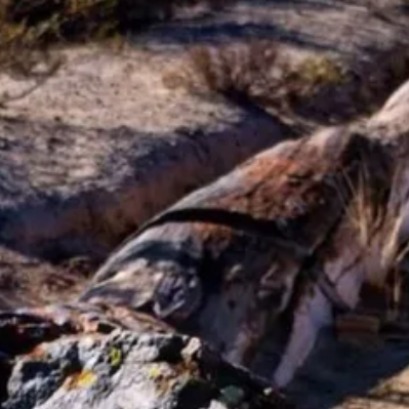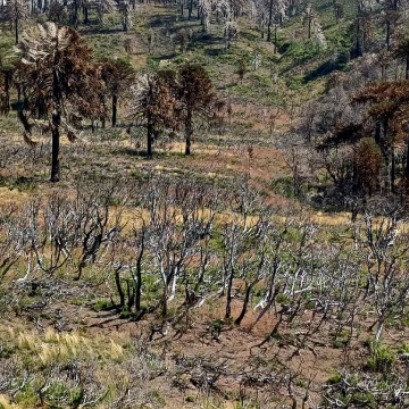
The forest of the oldest shadows: the story of the petrified trees
One of the natural treasures of Río Negro turns 23 years old under the protection law that allows its conservation. Where it is and how it was formed. Río Negro celebrates 23 years of conservation in the petrified forest as a Protected Natural Area (ANP). It is a space of 625 hectares that protects an exceptional site of fossil trunks that date back more than 60 million years.
The petrified forest of Río Negro is an unparalleled place that continues to reaffirm its paleontological, educational and tourist value within the ANP Provincial System, and its value as a Natural Monument. Created by Provincial Law N 2669 in 2002, under the category of “Natural Monument” (Law N 3689), this 625-hectare space protects an exceptional site of fossil logs dating back more than 60 million years. years. They preserve remains of ancient forests that populated the region during the Paleocene period, when the temperate and humid climate favored exuberant vegetation similar to araucarias and other tropical species in the current territory of Río Negro. The petrification process that gave rise to this forest occurred under unique conditions: the trunks were dragged by ancient currents towards areas rich in salts and covered by sediments without oxygen, where minerals slowly replaced organic matter. This natural phenomenon allowed us to preserve in great detail the original structure of the trees, including branches, fruits and seeds, offering a window to the geological past of Patagonia. In addition to its scientific value, the petrified forest of Valcheta is a prominent tourist attraction in the Southern Region. Its landscape, dominated by jarillas and local birds, combines the strength of the Patagonian desert with the ancient footprint of fossils. The Environmental Guard Corps of the Provincial Secretariat of Environment and Climate Change plays a fundamental role in the protection, conservation and monitoring of the area. Its permanent presence allows the paleobotanical remains to be preserved, guarantee responsible visits and strengthen the link between the community and this unique natural heritage. Twenty-three years after its creation, the Petrified Forest of Valcheta continues to be an emblem of Rio Negros natural history and a living testimony of the provincial commitment to environmental conservation and scientific knowledge. How to visit the petrified forest The petrified forest is located very close to the urban area of ??Valcheta. The town is located about 100 kilometers from San Antonio Oeste and Las Grutas, on the RN23, on the so-called Southern Line. During the tours through the area of ??the petrified forest, and with the help of specialized guides, visitors can recreate with their imagination what those immense forests were like and the life that developed there. There are various types of petrified logs that can be seen. Some of them measure more than 30 meters and many are preserved vertically. The petrified forest area can be explored on foot or through a system of bicycle trails. In addition, you can visit the Petrified Forest Natural Museum and the Regional Museum of Valcheta, which houses a vast collection of archaeological, geological, paleobotanical and historical treasures. The protected area where the petrified forest is located is very close to the urban center of Valcheta and can be visited throughout the year.
IT MAY INTEREST YOU
 Specialists from 10 provinces develop forest landscape restoration strategies throughout the country
Specialists from 10 provinces develop forest landscape restoration strategies throughout the country
The program is developed by researchers from INTA, Conicet and the Argentine Wildlife Foundation.
 They promote research in pine resins from the NEA
They promote research in pine resins from the NEA
The forestry industry is one of the most important sectors in the economies of Misiones and Corrientes. Thousands of hectares of pine supply the paper, pulp, boards and sawmill industry. Pinus elliottii, one of the species established in the region, in addition to providing wood, is used to produce resin, a non-wood forest product with high demand in the chemical, pharmaceutical and cosmetic industries. In 2\024, resin extraction of approximately 52,6\0\0 tons was achieved from approximately 18,\0\0\0,\0\0\0 trees in production, generating income and jobs with high expansion potential.
 Missions | New illegal felling in the Piñalito Provincial Park in San Pedro reveals the silent expansion of deforestation in protected areas
Missions | New illegal felling in the Piñalito Provincial Park in San Pedro reveals the silent expansion of deforestation in protected areas
The advance of deforestation on protected areas was once again evident this week in the Piñalito Sur Provincial Park, in San Pedro, where the Ministry of Ecology and Renewable Natural Resources confirmed a new case of selective illegal logging. The event occurs in a context of growing concern about the fragility of the environmental control system in rural and border areas, where the scarcity of resources, personnel and logistics limits the capacity of surveillance against criminal organizations organized to steal native woods and market them on the black market in connivance with sawmill owners.





















